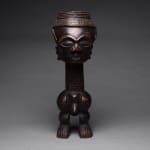Kuba Wooden Palm Wine Cup, 20th Century CE
Wood
35.9 x 12.7 cm
14 1/8 x 5 in
14 1/8 x 5 in
PF.4622 (LSO)
Further images
This impressive wine cup was made by the Kuba people of Gabon and what used to be Zaire. It is an unusual example, with a long, columnar neck/torso, short, flexed...
This impressive wine cup was made by the Kuba people of Gabon and what used to be Zaire. It is an unusual example, with a long, columnar neck/torso, short, flexed legs and a very large head which contains the receptacle that held the palm wine. The legs are plain and segmented, and the genitalia are clearly marked. The body is decorated with geometric patterning/hatching, giving rise to an outsized head that is surprisingly naturalistic for the genre. The features are carved with geometric boldness but without the deconstruction that is common in such pieces. The eyes are closed under strong browridges, and an inverted T-bar nose and a prognathic mouth. The face is encircled with ornate hatched hair. While unpainted, the piece has a good patina from age and handling.
The Kuba are a large tribe comprised of various smaller entities including the Bushoong, Ngeende, Kete, Lele, Binji, Dengese, Mbuun and Wongo peoples. They are quasi-autonomous within the Kuba polity but are related genetically and artistically. Their social systems are hereditary monarchies headed by the “Mushenge” (Nyim), who is responsible for the spiritual and material wealth of his people; each of the subgroups was represented by an elder who sat on a royal council. The kingdom was founded in the early 17th century by a major leader named Shyaam a-Mbul a Ngoong-Shyaam who united disparate groups under his authority. The resulting entity became highly productive and exploited trade networks through the area, becoming very wealthy in the process. This led to an increased artistic oeuvre and ever more elaborate royal regalia and statuary. Their religion was based upon a creator god named MBoom, while more immediate concerns were the province of a being named Woot who was involved with more tangible issues; the Kuba are also known as the Children of Woot. While not impacted upon by slavery, their kingdom fell to the Nsapo people in the 19th century, and was eventually subsumed into the Belgian Empire.
Artistically, the Kuba are highly prolific. Their art is often extremely ornate and decorated with cowrie shells and geometric and meandriform linear motifs. Their large wood sculptures have an apotropaic function. Much Kuba art is decorated with Tukula – bright red ground camwood powder (called twool by the Kuba), which has a symbolic significance for the group. In addition to the beautifully-rendered court art such as the Ndop statues – which represent kings – they have a habit of decorating utilitarian objects to such an extent that they have been described as a people who cannot bear to leave a surface without ornament. They are perhaps best known for their boxes (ngedi mu ntey) and palm wine cups. These items were used as markers of status in the late 19th century, and the quality of their rendering was used as a bargaining chip when attempting to gain royal favour or influence.
This unusual example of the genre would sit well in any good collection of African art.
The Kuba are a large tribe comprised of various smaller entities including the Bushoong, Ngeende, Kete, Lele, Binji, Dengese, Mbuun and Wongo peoples. They are quasi-autonomous within the Kuba polity but are related genetically and artistically. Their social systems are hereditary monarchies headed by the “Mushenge” (Nyim), who is responsible for the spiritual and material wealth of his people; each of the subgroups was represented by an elder who sat on a royal council. The kingdom was founded in the early 17th century by a major leader named Shyaam a-Mbul a Ngoong-Shyaam who united disparate groups under his authority. The resulting entity became highly productive and exploited trade networks through the area, becoming very wealthy in the process. This led to an increased artistic oeuvre and ever more elaborate royal regalia and statuary. Their religion was based upon a creator god named MBoom, while more immediate concerns were the province of a being named Woot who was involved with more tangible issues; the Kuba are also known as the Children of Woot. While not impacted upon by slavery, their kingdom fell to the Nsapo people in the 19th century, and was eventually subsumed into the Belgian Empire.
Artistically, the Kuba are highly prolific. Their art is often extremely ornate and decorated with cowrie shells and geometric and meandriform linear motifs. Their large wood sculptures have an apotropaic function. Much Kuba art is decorated with Tukula – bright red ground camwood powder (called twool by the Kuba), which has a symbolic significance for the group. In addition to the beautifully-rendered court art such as the Ndop statues – which represent kings – they have a habit of decorating utilitarian objects to such an extent that they have been described as a people who cannot bear to leave a surface without ornament. They are perhaps best known for their boxes (ngedi mu ntey) and palm wine cups. These items were used as markers of status in the late 19th century, and the quality of their rendering was used as a bargaining chip when attempting to gain royal favour or influence.
This unusual example of the genre would sit well in any good collection of African art.





